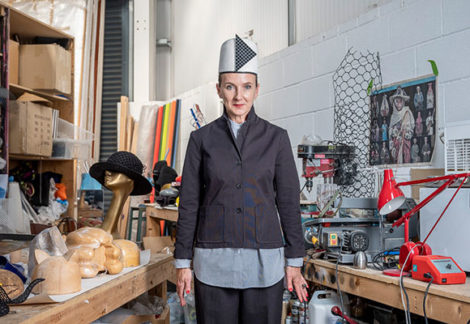British fashion designer and Field Grey favourite Flora McLean launched her millinery label House of Flora in 1996. Since then, she’s dressed some of the world’s most famous women. Her unique use of materials and techniques has earned her a place in the fashion hall of fame, and when she’s not creating marvellous millinery, she teaches the subject at the Royal College of Art, nurturing the next generation of hat and accessory makers.
Flora starred in our Readywear campaign, shot by Peter Searle in 2018. We caught up with Flora to talk about her move into menswear, who she’d like to make hats for, and what the future of fashion education has in store…
Hi, Flora! Can you give us a brief synopsis of your career so far, and the House of Flora brand?
Well, I never really thought of it as a career – I just make things! I studied Fashion Design, womenswear and menswear, but all my classmates knew I’d do accessories. They knew before I did. I met some cool product designers and made an inflatable collection, working with Nick Crosbie. Nick runs a company called Inflate, and we made weird accessories as part of my collection. That shaped what I would do in the future. Things just ended up going on people’s heads! We were playing around with what a hat might be.
I won a Kangol hat prize when I was at college; that had a big impact. I worked with an amazing milliner, Marie O’Regan, who was very strict. She’d get to me to make things again and again and again. We designed a hat that ended up being sold in Harrods and I thought, ‘I’m on to something here… maybe I should do hats?’ It wasn’t until I had my first kid, a year out of college, when I got a bit twitchy and needed to make something. Lots of my friends had started magazines or were working as stylists. A friend of mine, Grace Cobb, used to do styling for various fashion shows. She got me to make some plastic stuff for Matthew Williamson’s show, and that’s how I met Neil Moodie, who did the hair, and we’ve worked on hats ever since.
After a while I’d accumulated a lot of stuff, and I started selling more and more pieces. The plastic beret had some amazing press, so I started building up this press book. It was like an illusion at the beginning, and then the illusion became real.
I got my brother-in-law to design a logo because back then I thought that if have headed notepaper, it meant you had a company.
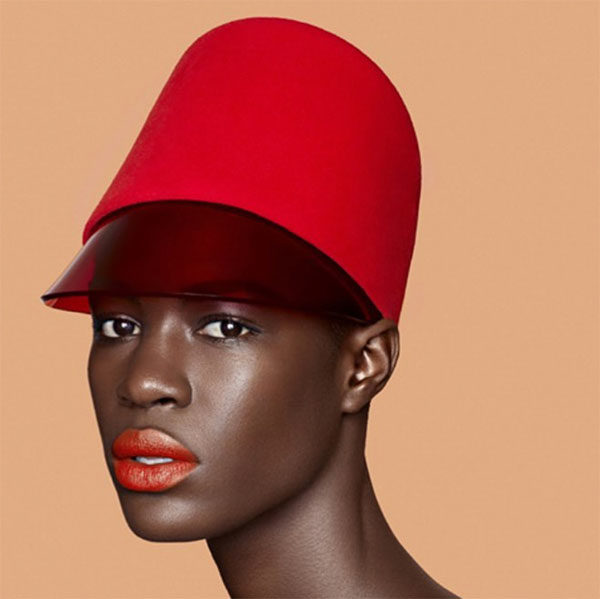
You grew up in a very creative household – can you tell us about that?
My family think in a different way – they’re not normal! My brother (Will McLean) is an architect and a writer, and he’s had a big influence on me; he’s very stylish.
I share a studio with my dad (Bruce McLean) – he’s a sculptor and he paints a lot. We’ve shared a studio for five years, and our work is almost merging. I’ve made a hat that looks like his prints, or he’s made a print that looks like one of my hats. It’s not intentional, it just sort of happens.
I think the most interesting part of growing up was when we stayed in Berlin – we had this wonderful freaky year when we moved there; dad got this studio and made loads of paintings, and we were hanging out with all these funny types. There was no babysitter, so my mum would drag us along to private views and we would be in nightclubs – I’m sure we weren’t meant to be there!
At the same time it was quite traumatic; being dragged away from the security of school and your mates, but it glued us together as a family. We had each other. My younger sister is more graphics, and my big sister studied textile design at Brighton and I used to help her when she was studying: that’s how I know how to print. My mum taught me how to sew, stitch, draw and cook – most things really!
Numerous famous faces have worn your creations – who is your favourite, and who would you love to dress?
My favourite at the moment is Erykah Badu. She started messaging me on Instagram – it was most bizarre. My friend called up and said, ‘you do realise that Erykah Badu is following you?’ I looked closely and thought, ‘Oh my God!’
She sent me a message saying, ‘I can see you’ and it went from there. I really don’t know how, but she’s become a mate. She came to the studio to get a taste of what she likes. I just got back from Amsterdam; I saw her play in Tilburg and took some other hats. She’s actually the first person I’ve met who’s ‘really famous’ and who I admire. With fashion shoots, I never meet them; stylists borrow things and then you end up seeing Rihanna wearing your hats in Elle Magazine. What’s interesting is everyone says Erykah must be so weird, but she’s not – she’s really smart, interesting and original. She’s just herself.
I’d really like to get a hat on Solange, and I’d like to get some hats on footballers. My son’s a footballer, and I’d love to do a shoot with famous footballers wearing menswear. I’m working on that…
What kind of impact did the Beyonce/The Face cover have?
It had such a huge impact. That was really down to Grace (Cobb), she was one of the editors of the time; Edward Enninful was working there at the time too, and he’s a fan. When Stephen Jones did Hats: An Anthology at the V&A years later, he called me up because of that image. I’d never met him before. He said, ‘I’d really like that hat to be in my show – I wish I’d made that hat!’
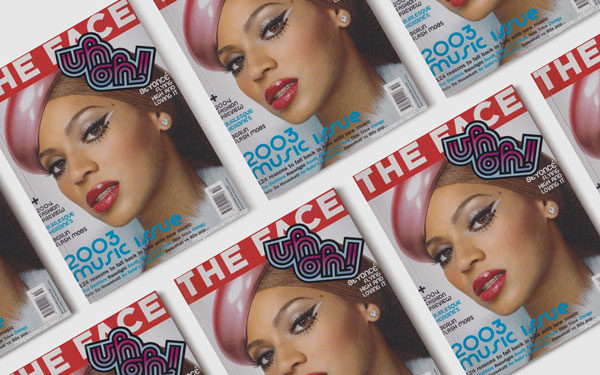
High praise indeed!
Yes, that image definitely made that moment, and then being in the V&A and their archive is really major. That hat is loved and loathed by many. Early on, I was looking for an agent to organise what I was doing; somebody suggested I go with Mandi Leonard. All the press came out, she saw the hat and said, ‘If I see that fucking hat in another fucking editorial I’m going to fucking scream!’ and I thought: ‘well this is not going to work, is it?’
I sell those hats all over the world and it’s fed my kids. I understand that it can be nauseating because it’s a novelty, but it’s become my trademark. I wonder what she thinks of it now?
Can a magazine still have the same impact in 2019?
Yes, I think so. Karlie Kloss wore some hats inside Vogue recently. That has done wonders for sales. It didn’t in the beginning; everybody used to say ‘oh, you must be selling loads!’ but, nope. It was just building up a presence, building the brand. I now know what that means, but at the time I didn’t realise and it was incredibly frustrating.
But, now, because of Instagram especially, people see things and they want to buy it immediately. You almost don’t need to do traditional trade fairs. You can make some movies and do a small exhibit, but having to stand on all those trade fairs seems very old-fashioned now. I did do that for about eight years – in Paris – and you build relationships with buyers and stores, and they remember you. And when you come back – and they’re all on Instagram now – they’re like ‘oh, it’s her again!’
Why did you decide to have a break?
I took a four-year gap recently and I now work in a more artistic, thoughtful way. There were various reasons: it was necessary to reboot, and I feel like I’m starting again, especially with the menswear.
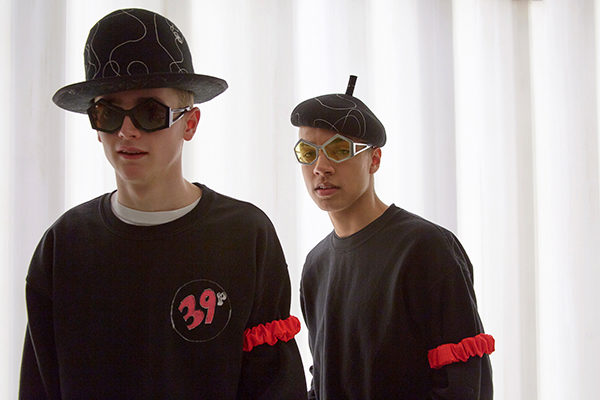
What considerations have you had to make when moving into menswear?
I think it’s a massive generalisation but you tend to make more classic shapes for men; they don’t want something too in your face. That really depends on the character; at the moment I’ve been designing hats specifically for individuals: musicians, artists, designers, mates; so they’re different. But if it’s someone who wants an interesting hat, someone older, they will probably go with more muted tones and less decoration. It’s more about the details. Less is more! Saying that, I’ve made a bright yellow hat covered in scribbles…
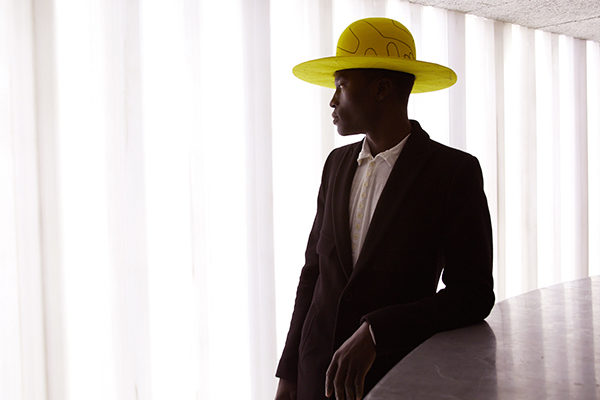
You starred in our Readywear campaign – how was that for you?
It was a really nice day! Peter (Searle) took some nice photographs and I really enjoyed the experience. I don’t usually like having my picture taken but Peter made you feel really relaxed and knew lots of tricks about what to do with your head. I’ve even remembered them since – every time someone picks up a camera I think, ‘I must do that thing!’
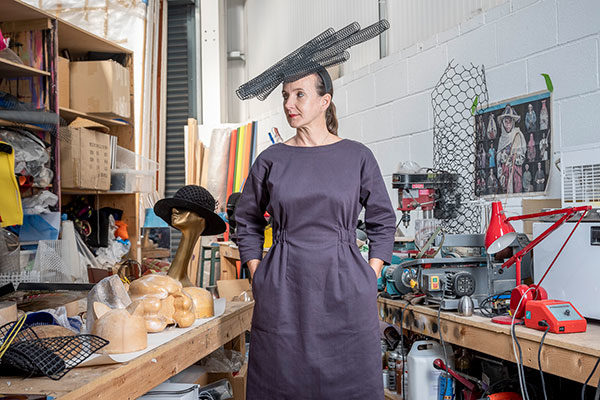
What are your thoughts about Readywear as a collection?
Well, they are the sort of things I’d wear to work. I’ve got two ways of dressing: I’m either a girl or a boy. Today I’m wearing big baggy pants, with tapered trouser legs, and a smart shirt; that would fit in with what Field Grey are doing with Readywear. The fabrics and styles remind me of Margaret Howell, and Katharine Hamnett in the 1980s – it’s very my family. It fits in with what we all wear! I think Readywear is really functional: it’s useful, smart and sharp.
What are your go-to items in your wardrobe?
I wear a lot of workwear and I do like wearing an apron or overalls in the studio. When I first met Janice (Field Grey’s founder and creative director), I used to wear an overall when I was teaching. They had lab coats and it meant you didn’t have to think about what to wear, which, in a fashion department, can be a bit of a relief! I don’t buy a lot of things; I tend to wear things until they fall apart. I think I buy clothes more like a guy, I know what I like and I go back and get it again when it’s worn out.
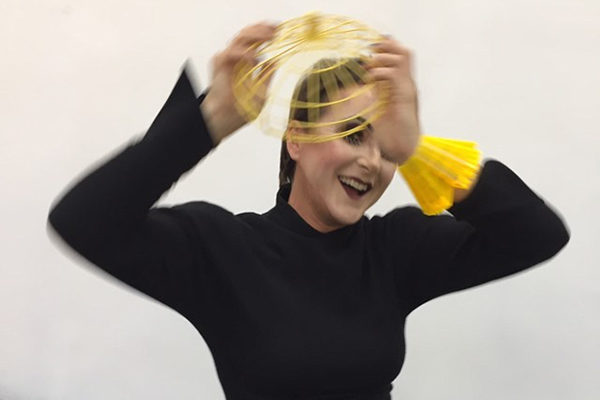
What’s happening in fashion education at the moment and what are the challenges that students face?
Big question! The fashion department at the RCA is in a really interesting place right now. Zowie (Broach) has settled into the role; when she first arrived, she flipsided the whole thing. What’s been interesting is she’s brought a scientific aspect: the students are growing their own materials, 3D printing whole looks, and using AI. And then there are students who are still building beautiful, structured, tailored garments in minute detail. There’s a fascinating range at the moment and Zowie is great at putting on shows.
A lot of students are actually thinking – do we actually need to make more? Maybe we just need to design it inside our minds. There was a girl last year who didn’t make a collection but chained herself to a truck instead, and wrote diaries and chartered all her experiences. It’s quite a different environment compared to seven years ago!
The challenges are mostly financial. Lots of British students, who don’t have shitloads of money, can’t go: it’s not diverse in the sense of who can get in. It seems very unfair. That’s not to say there aren’t some fantastic students, but there’s only one from the UK.
Is the lack of diversity based solely on who can afford it?
I think a lot of students just don’t think it would even be an option; if you’re going to spend that kind of money, you could just start a studio, and intern for various people, and learn that way. I think people have to weigh up why they would come to the RCA.
What’s the best thing about working at an institution like the RCA?
The best thing for me is the technicians and their willingness to help you make. These are people who, when they’re not working there, are practicing artists, designers and engineers, and they’re genius.
The uniform industry is notoriously behind when it comes to sustainability and the fashion industry is increasingly problematic. Do you have any thoughts on this in the work that you do?
Because what I do is so small I don’t think I have a huge environmental impact. I also like to pay people. I don’t have interns that I don’t pay – if I employ people, I pay them. If I can’t afford them, I don’t employ them.
In terms of quality and make, my early influence of fashion was my mum who would buy a lot of the Katherine Hamnett garments I mentioned: all those clothes I inherited still work and function. They are not in landfill. I’m still using them and I can pass them to my kids – I have three boiler suits and they’re genius. They’re brilliant pieces of clothing that could be uniform. They were uniform!
I suppose it’s down to how you design and construct something and the fabrics you use: things should just last. And if they do wear, they wear in a way that you want them to. The colours change, and you’ve thought about what the garment will turn into when you’ve washed it repeatedly. That’s clever – to think ahead: what will this look like in the future? I love that.
Finally, what advice would you give to a budding milliner?
I’d say: extend your repertoire beyond a hat! Don’t limit yourself; maybe think about eyewear. There aren’t a lot of eyewear designers, and both are linked. Think about what kind of milliner you want to be.
Also: know who your influences are, and your history. What’s the thing that makes you want to do this? There are certain artists and designers who I look at again and again just to remind me of who I am. Know your ingredients – on every level.
houseofflora.net

